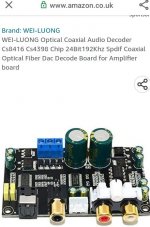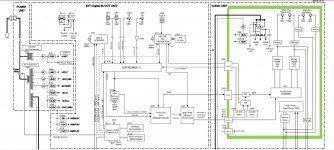2nd harmnic distortion is on -135dB so how high volume do you think you have to play in your room until this signal will be measurable or even audible?
You can actually try another thing. ...
Maybe some of you think that this is woodoo? ...
A simple short cut... then you tap on it and listen.
Hi esl63,
So may I ask if you are saying that 'distortion and (vibration free) noise' as measured by FFT is not necessarily all there is to SQ?
Hi Guys,
Here is an approach I have taken: Both bohrok2610 and abraxalito have pointed out some possible alternate technical approaches. In this case, looks more or less like galvanic isolation of I2S and or of I2C, as versus careful PCB layout. For an R&D prototype to find out what is the best I can do, I use both methods (isolators can be bypassed for comparison). My thought is that if I am happy with the best of everything I know how to do, I can then compare the sound of that with a really good commercial dac and with some simplified prototypes of mine. If my all-out R&D dac performs best by far, then I may decide my simplified prototype is too simplified. Or, if the all-out R&D dac doesn't perform best of all, I know I have a problem to be investigated and fixed before I move on. The R&D dac is just for my personal use and to have some kind of reference for what is possible (or, say, maybe the really good commercial dac will serve as the reference if its designer knows more than me). In any case, I need to have a standard reference of the best I have heard and or measured to compare with some simpler, lower cost, more practical type of prototype dac. Without a reference of what is possible, IME its hard to optimize a more practical dac. Even at that, sometimes near-SOA phono or tape is necessary for verification that the reference dac is not too far off in some musical/perceptual way I didn't happen to think of before (maybe some stereo illusion thing). Don't know if such a strategy would or could be helpful to others, but I like it. 🙂
With that I will leave off here for today.
Here is an approach I have taken: Both bohrok2610 and abraxalito have pointed out some possible alternate technical approaches. In this case, looks more or less like galvanic isolation of I2S and or of I2C, as versus careful PCB layout. For an R&D prototype to find out what is the best I can do, I use both methods (isolators can be bypassed for comparison). My thought is that if I am happy with the best of everything I know how to do, I can then compare the sound of that with a really good commercial dac and with some simplified prototypes of mine. If my all-out R&D dac performs best by far, then I may decide my simplified prototype is too simplified. Or, if the all-out R&D dac doesn't perform best of all, I know I have a problem to be investigated and fixed before I move on. The R&D dac is just for my personal use and to have some kind of reference for what is possible (or, say, maybe the really good commercial dac will serve as the reference if its designer knows more than me). In any case, I need to have a standard reference of the best I have heard and or measured to compare with some simpler, lower cost, more practical type of prototype dac. Without a reference of what is possible, IME its hard to optimize a more practical dac. Even at that, sometimes near-SOA phono or tape is necessary for verification that the reference dac is not too far off in some musical/perceptual way I didn't happen to think of before (maybe some stereo illusion thing). Don't know if such a strategy would or could be helpful to others, but I like it. 🙂
With that I will leave off here for today.
Last edited:
You can actually try another thing. If there is ceramic caps in the signal path you can add sticky "blue tac" or use thermo glue on them. This will reduce vibrations and microphonic feedback.
Maybe some of you think that this is woodoo? You can easily test this by solder a cheramic cap to an RCA cable and plug it in on the phono preamp input.
A simple short cut... then you tap on it and listen.
You will be surprised to hear all that noise!
So this is basicly why people tend to put their hifi gear on solid or suspended shelfs.
i don’t hear any feedback at all from the DAC.
Are you sure the ceramic caps you tried are in the signal path?
was that for me?
I once modded an old NAD CD Player from the 90ies (I like the classic NAD design), it had only an ancient 14 bit DAC in it.
Added to the voltage regulators some Cs as described in the datasheet and changed the output OP amp to LM4562.
The sound was so good after that, that I wonder if DAC technology is as important as is guessed.
Added to the voltage regulators some Cs as described in the datasheet and changed the output OP amp to LM4562.
The sound was so good after that, that I wonder if DAC technology is as important as is guessed.
The advancement in DAC technology should be audible. But I had not the impression that the modded NAD player was missing something. This is purely subjective. For me it seems that the digital section does not play that sonic role for good audio.What makes you think people are guessing?
 If you like the Marantz so much, how about a different solution, get a cheap DAC based on the same chip and modify it, this one comes with a socketed ne5532, so you could easily try fancy op amps, as well as upgrading capacitors and using a decent power supply. I guess Marantz know a thing or two about making DACs, so you'd probably have to mod it just to be equal, but it may be possible to surpass the sound of the DAC you have, and they're cheap, so there's not much to loose. In fact they're so cheap, you could have a SPDIF splitter, and have a DAC and mono0block under each speaker.
If you like the Marantz so much, how about a different solution, get a cheap DAC based on the same chip and modify it, this one comes with a socketed ne5532, so you could easily try fancy op amps, as well as upgrading capacitors and using a decent power supply. I guess Marantz know a thing or two about making DACs, so you'd probably have to mod it just to be equal, but it may be possible to surpass the sound of the DAC you have, and they're cheap, so there's not much to loose. In fact they're so cheap, you could have a SPDIF splitter, and have a DAC and mono0block under each speaker.The Cs 4344 DAC chip can be used without an op amp, just some capacitors between it and the rca outs (I've tried this, and quite like the sound), perhaps the Cs 4398 is the same?
Looks like it is voltage out. Recommended output stage appears to consist of an differential summing MFB filter.
Just using an output coupling cap and skipping the filtering altogether may not be ideal though. DAC1 looks to have a discrete LP filter in the output stage.
Just using an output coupling cap and skipping the filtering altogether may not be ideal though. DAC1 looks to have a discrete LP filter in the output stage.
OP has a closed account now, FYI…
Dac threads, much like the devices themselves, usually go quiet soon after the direct output claims start floating around.
Dac threads, much like the devices themselves, usually go quiet soon after the direct output claims start floating around.
After further investigation, I did find some indication that the 4398 can smoke when capacitor coupled (something to do with instability, apparently ) perhaps just plugging in a fancy op amp would be the way to go. If a dac costs £10 or less, (4344 for example) an early demise is no big deal.
- Home
- Source & Line
- Digital Line Level
- Any ideas on modding this DAC? Topping D30pro
